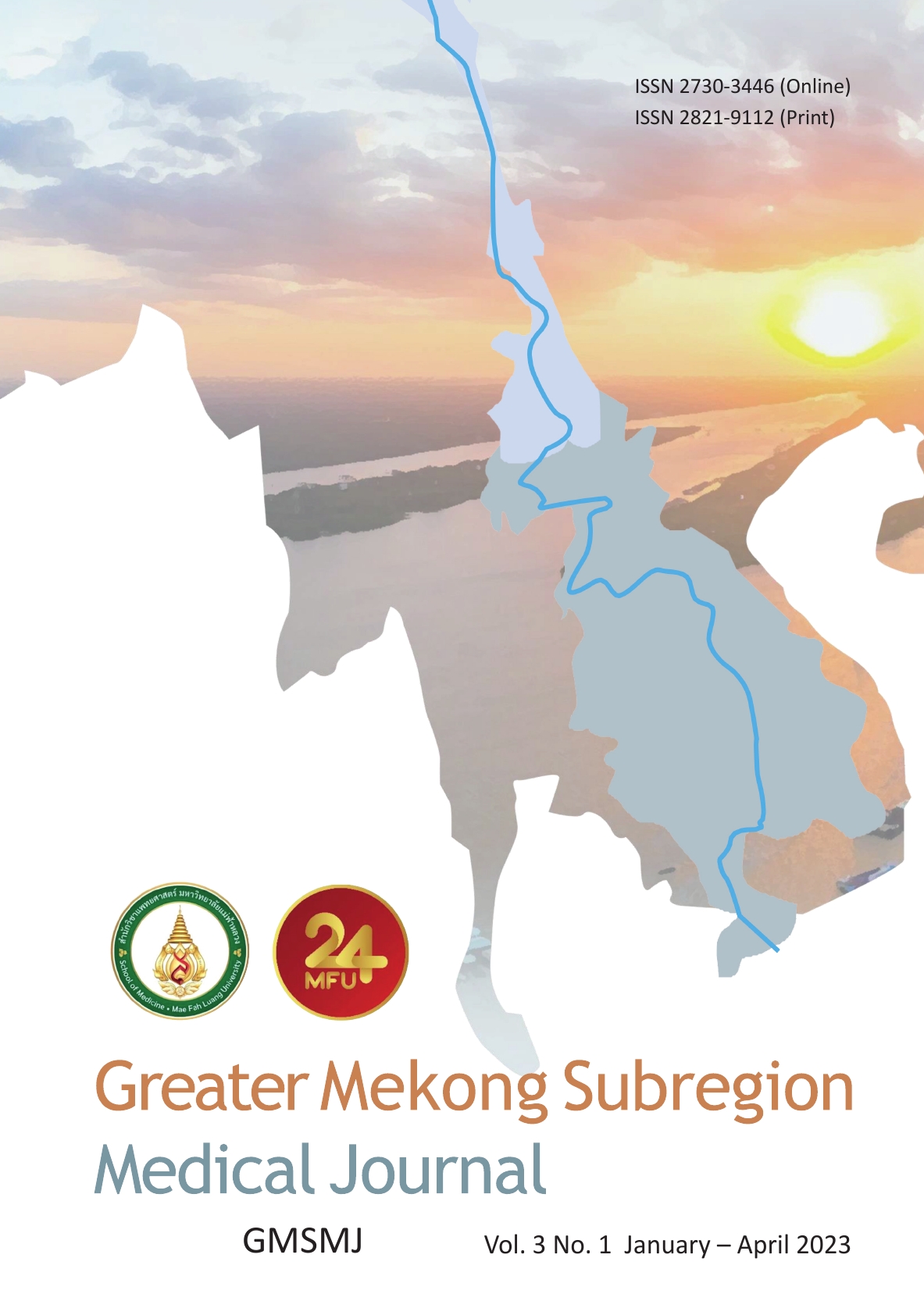Sequential Conditioning Un-manipulated Haploidentical Hematopoietic Stem Cell Transplantation in A Patient with High Risk and Refractory Acute Myeloid Leukemia by Using A Second-degree Relative Donor
Keywords:
Refractory acute myeloid leukemia, Sequential conditioning, Hematopoietic stem cell transplantationAbstract
Following the second course of induction chemotherapy, only 10 to 20 percent of patients with relapsed/refractory acute myeloid leukemia can achieve complete remission. We reported the case of a patient with high-risk, refractory acute myeloid leukemia who underwent sequential conditioning T cell-replete haploidentical hematopoietic stem cell transplantation with post-transplant cyclophosphamide from a second-degree relative donor. The sequential conditioning regimen consisted of thiotepa 5 mg/kg on days -15 and -14, etoposide 100 mg/m2 on day-13 to -10, cyclophosphamide 400 mg/m2 on day-13 to -10, and mesna on day-13 to -10, followed by fludarabine 30 mg/m2 on day-6 to -2, and melphalan 140 mg/m2 on day-2. The graft-versus-host disease prophylaxis regimen consisted of cyclophosphamide, tacrolimus, and mycophenolate mofetil. Neutrophil and platelet engraftment occurred on day +15 and +32. On day+56, the patient developed CMV reactivation, which was successfully treated with ganciclovir. The last follow-up was on day +300; the patient remained in complete remission. He had mild chronic graft-versus-host disease of the oral mucosa, mild anemia, and mild thrombocytopenia. This patient demonstrated that sequential conditioning T cell- replete haploidentical hematopoietic stem cell transplantation utilizing a second-degree relative donor is feasible and may be a promising therapy option for patients with relapsed/refractory acute myeloid leukemia.
References
Döhner H, Weisdorf DJ, Bloomfield CD. Acute Myeloid Leukemia. Longo DL, editor. N Engl J Med. 2015; 373 (12): 1136-52. https://doi.org/10.1056/NEJMra1406184 PMid:26376137
Löwenberg B, Burnett A. Acute Myeloid Leukemia. N Engl J Med. 1999; 12. https://doi.org/10.1056/NEJM199909303411407 PMid:10502596
Roussel X, Daguindau E, Berceanu A, Desbrosses Y, Warda W, Neto da Rocha M, et al. Acute Myeloid Leukemia: From Biology to Clinical Practices Through Development and Pre-Clinical Therapeutics. Front Oncol. 2020; 10: 599933. https://doi.org/10.3389/fonc.2020.599933 PMid:33363031 PMCid:PMC7757414
Estey E, Kornblau S, Pierce S, Kantarjian H, Beran M, Keating M. A stratification system for evaluating and selecting therapies in patients with relapsed or primary refractory acute myelogenous leukemia [letter]. Blood.1996; 88: 756. https://doi.org/10.1182/blood.V88.2.756.bloodjournal882756 PMid:8695828
Estey E. Treatment of relapsed and refractory acute myelogenous leukemia. Leukemia. 2000; 14 (3): 476-9. https://doi.org/10.1038/sj.leu.2401568 PMid:10720145
Döhner H, Estey E, Grimwade D, Amadori S, Appelbaum FR, Büchner T, et al. Diagnosis and management of AML in adults: 2017 ELN recommendations from an international expert panel. Blood. 2017; 129 (4): 424-47. https://doi.org/10.1182/blood-2016-08-733196 PMid:27895058 PMCid:PMC5291965
Döhner H, Ebert B, Godley L, Levine R, Ossenkoppele G. Diagnosis and Management of AML in Adults: 2022 ELN Recommendations from an International Expert Panel. 2022; 58. https://doi.org/10.1182/blood.2022016867 PMid:35797463
Keren-Froim N, Heering G, Sharvit G, Zlotnik M, Nagler A, Shimoni A, et al. ELN 2017 classification significantly impacts the risk of early death in acute myeloid leukemia patients receiving intensive induction chemotherapy. Ann Hematol. 2022; 101 (2): 309-16. https://doi.org/10.1007/s00277-021-04716-4 PMid:34989829
Gyurkocza B, Lazarus HM, Giralt S. Allogeneic hematopoietic cell transplantation in patients with AML not achieving remission: potentially curative therapy. Bone Marrow Transplant. 2017; 52 (8): 1083-90. https://doi.org/10.1038/bmt.2017.8 PMid:28244979
Nagler A, Savani BN, Labopin M, Polge E, Passweg J, Finke J, et al. Outcomes after use of two standard ablative regimens in patients with refractory acute myeloid leukaemia: a retrospective, multicentre, registry analysis. Lancet Haematol. 2015; 2 (9): e384-92. https://doi.org/10.1016/S2352-3026(15)00146-5 PMid:26685771
Schmid C, Schleuning M, Ledderose G, Tischer J, Kolb HJ. Sequential Regimen of Chemotherapy, ReducedIntensity Conditioning for Allogeneic Stem-Cell Transplantation, and Prophylactic Donor Lymphocyte Transfusion in High-Risk Acute Myeloid Leukemia and Myelodysplastic Syndrome. J Clin Oncol. 2005; 23 (24): 5675-87. https://doi.org/10.1200/JCO.2005.07.061 PMid:16110027
Fraccaroli A, Prevalsek D, Fritsch S, Haebe S, Bücklein V, Schulz C, et al. Sequential HLA-haploidentical transplantation utilizing posttransplantation cyclophosphamide for GvHD prophylaxis in high-risk and relapsed/refractory AML/MDS. Am J Hematol. 2018; 93 (12): 1524-31. https://doi.org/10.1002/ajh.25281 PMid:30194866
Heinicke T, Labopin M, Polge E, Stelljes M, Ganser A, Tischer J, et al. Evaluation of six different types of sequential conditioning regimens for allogeneic stem cell transplantation in relapsed/refractory acute myelogenous leukemia - a study of the Acute Leukemia Working Party of the EBMT. Leuk Lymphoma. 2021; 62 (2): 399- 409. https://doi.org/10.1080/10428194.2020.1827248 PMid:33040622
Jondreville L, Roos-Weil D, Uzunov M, Boussen I, Grenier A, Norol F, et al. FLAMSA-Busulfan-Melphalan as a Sequential Conditioning Regimen in HLA-Matched or Haploidentical Hematopoietic Stem Cell Transplantation for High-Risk Myeloid Diseases. Transplant Cell Ther. 2021; 27 (11): 915.e1-915.e8. https://doi.org/10.1016/j.jtct.2021.07.018 PMid:34329755
Ringdén O, Labopin M, Schmid C, Sadeghi B, Polge E, Tischer J, et al. Sequential chemotherapy followed by reduced-intensity conditioning and allogeneic haematopoietic stem cell transplantation in adult patients with relapse or refractory acute myeloid leukaemia: a survey from the Acute Leukaemia Working Party of EBMT. Br J Haematol. 2017; 176 (3): 431-9. https://doi.org/10.1111/bjh.14428 PMid:27879990
Schmid C. Long-term survival in refractory acute myeloid leukemia after sequential treatment with chemotherapy and reduced-intensity conditioning for allogeneic stem cell transplantation. Blood. 2006; 108 (3): 1092-9. https://doi.org/10.1182/blood-2005-10-4165 PMid:16551971
Saraceni F, Labopin M, Brecht A, Kröger N, Eder M, Tischer J, et al. Fludarabine-treosulfan compared to thiotepa-busulfan-fludarabine or FLAMSA as conditioning regimen for patients with primary refractory or relapsed acute myeloid leukemia: a study from the Acute Leukemia Working Party of the European Society for Blood and Marrow Transplantation (EBMT). J Hematol OncolJ Hematol Oncol. 2019; 12 (1): 44. https://doi.org/10.1186/s13045-019-0727-4 PMid:31023346 PMCid:PMC6482556
Sheth V, Labopin M, Canaani J, Volin L, Brecht A, Ganser A, et al. Comparison of FLAMSA-based reduced intensity conditioning with treosulfan/fludarabine conditioning for patients with acute myeloid leukemia: an ALWP/EBMT analysis. Bone Marrow Transplant. 2019; 54 (4): 531-9. https://doi.org/10.1038/s41409-018-0288-0 PMid:30087463
Luznik L, O'Donnell PV, Fuchs EJ. Post-Transplantation Cyclophosphamide for Tolerance Induction in HLAHaploidentical Bone Marrow Transplantation. Semin Oncol. 2012; 39 (6): 683-93. https://doi.org/10.1053/j.seminoncol.2012.09.005 PMid:23206845 PMCid:PMC3808078
Chang YJ, Luznik L, Fuchs EJ, Huang XJ. How do we choose the best donor for T-cell-replete, HLA-haploidentical.
Downloads
Published
How to Cite
Issue
Section
License
Copyright (c) 2022 Greater Mekong Sub-region Medical Journal

This work is licensed under a Creative Commons Attribution-NonCommercial-NoDerivatives 4.0 International License.






